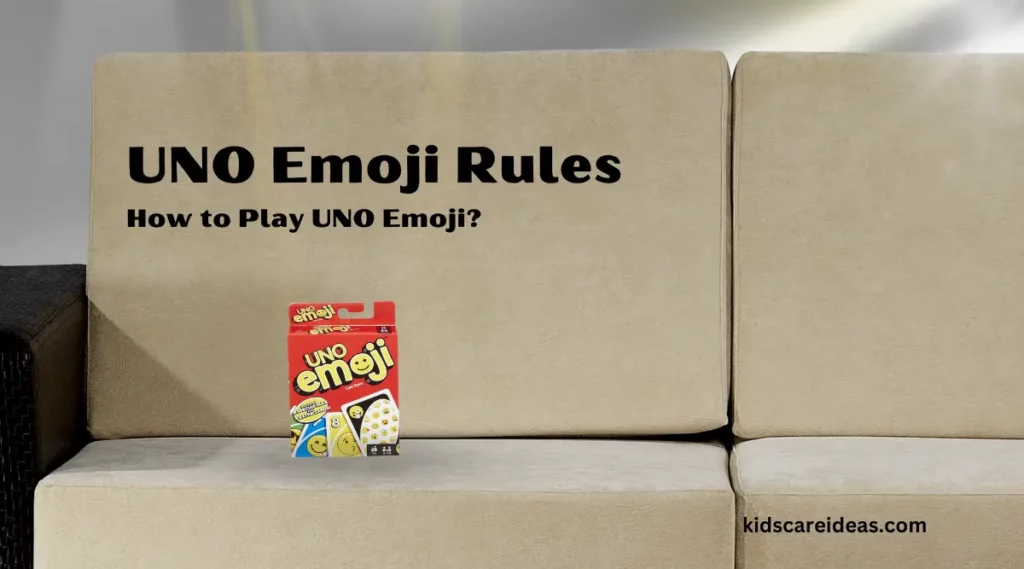UNO Emoji is an interesting Edition of the classic UNO card game. If you have already played by the Official UNO rules of the classic UNO, then you will be much more familiar with the basic rules.
Even if you are completely new to this game and just learning UNO Emoji Rules and how to play the game, then don’t worry, you will learn completely by reading this post.

So, Let’s get started!
What are UNO Emoji and its Objectives?
The objective of the Uno Emoji game is to be the first player to get rid of all the cards. The primary objective is almost the same as that of Uno. The scores are counted at the end of each round. The first player who reaches the mark of a cumulative 500 score becomes the winner.
So, there are two ways to win: get rid of all cards before the other player or be the first player to score 500 points.
UNO Emoji Rules: For Different Action Cards
UNO Emoji like other UNO versions have different rules for their Action cards to play. The UNO Emoji rules make the game much more interesting and you get to see an amazing new card here known as the Wild Emoji Card.
Wild Card
This is one of the most helpful action cards in the game. The player who plays the wild card can choose the color that will continue for the rest of the game. They could also choose any color in the play before laying down the wild card.
Wild cards can be played even if the player has another playable card. If the wild card is placed at the game’s begging, the player, just to the dealer’s left, will decide the color that will continue for the rest of the game.
Draw Two Card
When a player draws this Draw +2 card, the next player will Draw 2 cards and thus miss their original chance. The players can use this card only on matching colors or draw 2 cards.
Even if the card appears at the game’s beginning, the same rule will follow
Wild Draw 4 Card
This card involves the usual perks of the wild card – that is, deciding which color suit will continue for the rest of the game also if a player plays the Wild Draw +4 cards, the next player will draw four cards and miss their chance.
This card can only be played when the player has no other card at hand matching the color of the discard pile. This card cannot be played at the game’s beginning, so if it turns up, the player has to return it and draw another card from the DRAW pile.
Wild Customizable Card
This one is a fun card. You can frame your own rules with this card. So, if there is any rule you wish to incorporate into the game, it could be any fun rule, you can simply write it on this wild customizable card with a pencil.
The only rule to follow is that – all other players should be at consent to the rule. Since it is a wild card, players can play it even if they have other playable cards. You can always write a new rule on the card – at every play.
Wild Emoji Card
The wild emoji card of the game goes with the emoji face card on top of it. When a player plays this card, the next player has to make the same face on their emoji face card, and the game will continue this way until the round comes again from where it started.
If the player stops making the relevant emoji face before their next turn, they must draw 4 cards as a penalty.
Reverse Card
Just as in Uno, the game direction changes when a player plays the reverse card. If the play continued anticlockwise, it would move clockwise and vice versa.
Like other cards, the reverse card can also be played only on cards of matching color or on another reverse card. The reverse card at the game’s beginning makes the dealer the first player, and instead of the game conventionally moving toward the left, it continues right.
Skip Card
When a player uses the skip card, the player next to them loses their turn. The card can be played only on another skip card or a card of matching color.
If the skip card is played at the game’s beginning, the player to the immediate left of the dealer will lose their turn, and the next player left to them will start the game.
How to Play UNO Emoji?
In this section, you will learn step by step on how to play UNO Emoji starting from setting the game to playing, scoring, and ending it.
Setting Up the Game
The game is relatively easy to set up, and the rules for setting up resemble that of Uno. Each player will draw a card, and the player who draws the card of the highest value becomes the game dealer. In this case, if the players draw any card with a symbol, it will be counted as zero.
Now, the dealer will shuffle the deck and deal 7 cards to each player. The remaining cards are placed in a facedown position to form the draw pile. The topmost card of the draw pile will be placed in the face-up position and form the foundations of the discard pile.
Playing UNO Emoji
The game starts with the player immediately on the left of the dealer. When a player gets the turn, they will match a card from the 7 cards they possess with the top card of the discard pile.
When we talk about matching – it will be in symbols, colors, or numbers. In the UNO emoji, cards with symbols are the action cards.
If a player does not have a card that matches the top card of the discard pile, they will take up a new card from the Draw pile. If this newly picked card can help the player, they will accept it and play it in the same turn. If not, they pass the card to the discard pile, and the game continues.
The player can also voluntarily choose not to play a particular card. In that case, they will draw a card from the Draw pile. But if the player draws a card, they lose chances to play any other card from hand at the same turn.
End of Game
As already discussed, the player who scores the 500 points mark at the earliest before other players win the game. The game-winner can also be the player who gets rid of all their cards before others.
Scoring in UNO Emoji
The scoring in Uno Emoji follows a specific rule – the first player who gets rid of all their cards in a particular round gets points for all the remaining cards in their opponent’s hands.
The scoring for different cards in the UNO deck goes as follows:
- Numbered cards: face value (0-9)
- Draw cards: 20 points
- Skip Cards: 20 points
- Reverse cards:20 points
- Wild Customizable cards: 50 points
- Wild Draw Four: 50 points
- Wild Emoji: 50 points
The scores are counted after each round. If any player has reached the 500 points mark at the end of a round, the game ends then and there. However, if no player reaches the 500 points mark, the cards are reshuffled, and a new game round starts. However, the scores of each player are carried forward.
There is also another unconventional way of scoring in Uno Emoji. According to this specific rule, after every round, a tally record of how far each player is from the 500 points mark is maintained.
For example, if a player has reached 380 marks, at the end of that round, their score will be 120, and so on. It reflects the player with the lowest score is on the verge of winning.
How is UNO Emoji different from Regular UNO Game?
Mattel has introduced the Uno Emoji version cards, which can be played by 2-10 pliers of age 7 and above. This is a fun version of the Uno game where the players must imitate the emojis on the card through their natural facial expressions.
It is a fun version to acknowledge the hype around emojis which are an internet sensation and has radically changed the communication pattern of the internet.
There are not many differences with regular Uno. In both card games, the objective is to be the first player to get rid of all the cards to win. Uno emoji has a social action card called the Emopji face card.
The game theme is unique; the only difference is that the players must keep up with the hilarious emoji expressions on their faces. Scoring and rules for other action cards remain the same.
Also, the players must scream Uno when they have the penultimate card at play. The game set-up, gameplay, and game end are similar to Uno.
Conclusion
Let’s conclude the post on UNO Emoji Rules and how to play it!
After reading this post, now you have learned all the rules properly. If you like other versions of UNO, then I have detailed rules for them too.
What’s Next? Check these UNO Versions!
Explore Other Versions of the popular card Game UNO:
